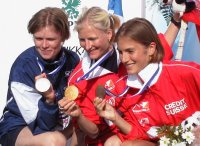 WOC 2001 took us to Tampere in Finland. This was a chance to see the first of the new "spectator-friendly" World Championships. So what difference did it make?
WOC 2001 took us to Tampere in Finland. This was a chance to see the first of the new "spectator-friendly" World Championships. So what difference did it make?On the face of it there were several "firsts". There was the first running of a new event - the "Sprint". There was the first real-time tracking of competitors in the Classic Race. For the first time the women's relay was finished before the men started. And for individual events the start was right next to the finish, rather than hidden away in the depths of the forest. But it was the TV coverage that came to dominate the week.
The first event of the week was the Sprint. This was a last-minute addition to the program, and nobody seemed really sure what it was meant to be. Most people seemed to be expecting a Park race, but the event was in a wooded area. The most controversial aspect was that competitors were given a map and allowed to train in the forest beforehand. Course planning turned out to be roughly equivalent to an Orange course, despite the fact that the area had intricate contour detail. Spectators were allowed anywhere on the main path network, although most stayed within about 100 metres of the start/finish. I wandered out to the edge of the map and found a bizarre control site. I now have what may be an extremely valuable photograph of the new World Champion, Vroni Konig of Switzerland, punching a control on the corner of the toilet block at Tampere Greyhound stadium. Back at the finish we had the first sighting of the massive TV screen and results board that will forever be a symbol of the week. The screen was the size of a double-decker bus, but then that is effectively what it was, since it came complete with its own driving cab. The results board was almost as big. The crowd spent most of its time watching the screens, which unfortunately meant they had their backs to the finish run-in, and so there was often very little noise and cheering even for the home runners.
The big attraction of the Classic race was meant to be the real-time tracking system. All competitors had to carry what was effectively a combined mobile phone and GPS receiver. This fitted into a vest which was large enough to ensure that every runner looked like they were running in a white O-top rather than the national team colours that people expected. TV coverage from the forest was extensive, although once you've watched one person slog uphill in hot sun to a control there is not a lot else to see. The trick as a runner was to make sure you started early and had a good run. As soon as you were outside of the top two or three that was your chance of TV fame gone, and the cameras moved on. TV is about winners. The situation was summed up when Yvette Hague finished in silence, and without any mention by the commentators, since she was only 11th and we already knew who had won the three medals. As for the tracking, it was as close to a non-event as it could be. We probably saw about three or four glimpses of the map with tracks on through the whole day, and this was unintelligible even to the experienced orienteer. Denmark promises the latest version of the technology. Will it be more intelligible this time?
Relay day provided more of the same, lots more of the same. If anything there were too many TV controls. With one every 10 minutes, it meant that the coverage never really got past the top three or four teams before moving on, which meant that most of the interesting racing was missed. The course planning was undoubtedly compromised by the spectator controls. It included a dog-leg which a C5 planner would be ashamed of with runners coming down a path to the assembly field, punching at a fodder rack 20 metres into the field, and then going straight back up the path. TV highlight of the day was the slow-motion replay to decide second and third place between Norway and Sweden in the Women's race. The Norwegian forgot to dip and lost it on the line.
I didn't see the Short race, since I was on the way back for the Scottish 6-Day. I've got a pretty good idea of what it was like though. Especially since it was on the same area as the Relay and the Short Race qualifier.
Overall I don't think things were as bad as I may have made out above. The areas were reasonable (though definitely nowhere near the best in Finland) and the weather was mainly sunny (apart from the odd thunderstorm). Great Britain didn't come back with the hoped-for medal. TV did dominate, but it was easier to follow what was going on than ever before. Apparently there was a two minute report on Transworld Sport on Channel 4. I missed it; I was in the shower at the time. But then I had of course seen the live version.
No comments:
Post a Comment